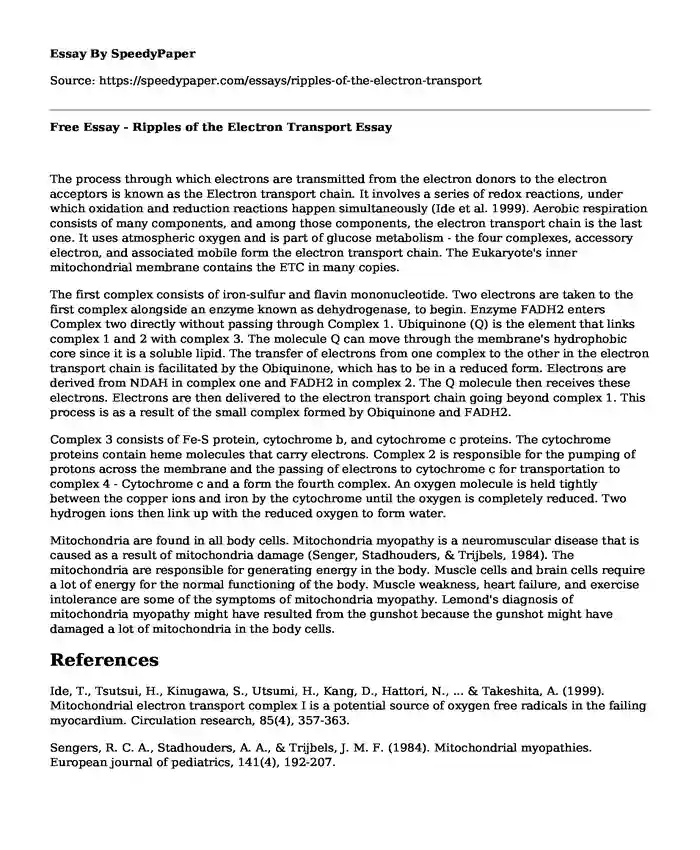The process through which electrons are transmitted from the electron donors to the electron acceptors is known as the Electron transport chain. It involves a series of redox reactions, under which oxidation and reduction reactions happen simultaneously (Ide et al. 1999). Aerobic respiration consists of many components, and among those components, the electron transport chain is the last one. It uses atmospheric oxygen and is part of glucose metabolism - the four complexes, accessory electron, and associated mobile form the electron transport chain. The Eukaryote's inner mitochondrial membrane contains the ETC in many copies.
The first complex consists of iron-sulfur and flavin mononucleotide. Two electrons are taken to the first complex alongside an enzyme known as dehydrogenase, to begin. Enzyme FADH2 enters Complex two directly without passing through Complex 1. Ubiquinone (Q) is the element that links complex 1 and 2 with complex 3. The molecule Q can move through the membrane's hydrophobic core since it is a soluble lipid. The transfer of electrons from one complex to the other in the electron transport chain is facilitated by the Obiquinone, which has to be in a reduced form. Electrons are derived from NDAH in complex one and FADH2 in complex 2. The Q molecule then receives these electrons. Electrons are then delivered to the electron transport chain going beyond complex 1. This process is as a result of the small complex formed by Obiquinone and FADH2.
Complex 3 consists of Fe-S protein, cytochrome b, and cytochrome c proteins. The cytochrome proteins contain heme molecules that carry electrons. Complex 2 is responsible for the pumping of protons across the membrane and the passing of electrons to cytochrome c for transportation to complex 4 - Cytochrome c and a form the fourth complex. An oxygen molecule is held tightly between the copper ions and iron by the cytochrome until the oxygen is completely reduced. Two hydrogen ions then link up with the reduced oxygen to form water.
Mitochondria are found in all body cells. Mitochondria myopathy is a neuromuscular disease that is caused as a result of mitochondria damage (Senger, Stadhouders, & Trijbels, 1984). The mitochondria are responsible for generating energy in the body. Muscle cells and brain cells require a lot of energy for the normal functioning of the body. Muscle weakness, heart failure, and exercise intolerance are some of the symptoms of mitochondria myopathy. Lemond's diagnosis of mitochondria myopathy might have resulted from the gunshot because the gunshot might have damaged a lot of mitochondria in the body cells.
References
Ide, T., Tsutsui, H., Kinugawa, S., Utsumi, H., Kang, D., Hattori, N., ... & Takeshita, A. (1999). Mitochondrial electron transport complex I is a potential source of oxygen free radicals in the failing myocardium. Circulation research, 85(4), 357-363.
Sengers, R. C. A., Stadhouders, A. A., & Trijbels, J. M. F. (1984). Mitochondrial myopathies. European journal of pediatrics, 141(4), 192-207.
Cite this page
Free Essay - Ripples of the Electron Transport. (2023, Feb 10). Retrieved from https://speedypaper.com/essays/ripples-of-the-electron-transport
Request Removal
If you are the original author of this essay and no longer wish to have it published on the SpeedyPaper website, please click below to request its removal:
Popular categories





